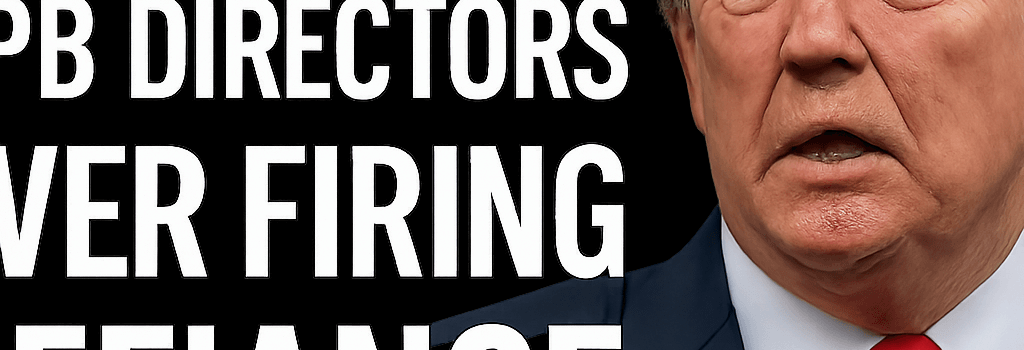Trump Sues CPB Directors Over Firing Defiance

Overview of the Dispute
On April 28, 2025, the White House issued termination notices to three Democratic‐appointed board members of the Corporation for Public Broadcasting (CPB)—Laura Ross, Thomas Rothman, and Diane Kaplan—citing the President’s authority under Article II of the U.S. Constitution. When the CPB publicized that it would maintain a five-member board despite the firings, the Department of Justice (DOJ) filed suit in the U.S. District Court for the District of Columbia, accusing the directors of “usurping and purporting to exercise unlawfully the office” of CPB board member.
Legal Arguments and Statutory Framework
Presidential Removal Power Under Article II
- The Administration cites Seila Law LLC v. Consumer Financial Protection Bureau (2020), where the Supreme Court affirmed broad presidential removal authority absent explicit statutory restrictions.
- DOJ’s complaint argues that without removal power, “the President cannot meaningfully exercise his executive power … without the power to select—and, when necessary, remove—those who hold federal office.”
DC Nonprofit Corporation Law
Under Title 29 of the D.C. Code § 291.01, “a director appointed by persons other than the members may be removed with or without cause by those persons”. In his June 8 order, Judge Randolph Moss noted that CPB could have amended its bylaws to insulate directors from removal but did not do so before the President acted.
District Court Proceedings
Both CPB and the fired directors filed suit on April 29, seeking an injunction to block the firings. CPB’s complaint emphasizes its status as a private nonprofit corporation created by Congress to operate “free from partisan governmental interference.”
Judge Moss: “I find it difficult to fathom that Congress intended to provide the members of the Corporation’s Board with essentially irrevocable tenure.”
Despite CPB’s argument that its 51‐page bylaws are the exclusive mechanism for director removal—and that no provision allows executive removal mid‐term—Judge Moss denied the preliminary injunction. He held that traditional DC corporate statutes applied where CPB had not explicitly opted out.
Implications for Federal Appointments Doctrine
This case tests the limits of presidential authority over quasi‐public entities. Legal scholars note parallels to Humphrey’s Executor v. United States (1935), which limited removal from independent agencies. Here, CPB sits in a grey area: congressionally chartered but privately incorporated. A ruling affirming the President could set a precedent for removal power over board members of other chartered nonprofits, such as Amtrak and the Federal Reserve.
Impact on Public Broadcasting Funding
Simultaneously, the Administration has asked Congress to rescind $1.1 billion in CPB funding—equivalent to two years of appropriations. In Senate hearings this week, Sen. Maria Cantwell (D-Wash.) warned that up to 79 stations in 34 states could lose federal grants, impacting emergency broadcast capabilities in fire‐ and hurricane‐prone regions.
- Over 70% of CPB’s annual appropriation funds 1,500+ public TV and radio stations.
- CPB programs reach 95% of American households, including Sesame Street and NPR Morning Edition.
- Recent impact study by the Senate Committee on Commerce, Science, and Transportation highlights risks to public safety communications.
Expert Opinions and Constitutional Debate
Constitutional law experts are divided:
- Pro-Removal Camp: Argues that absent clear congressional limitation, the Executive enjoys broad removal power, bolstered by decisions like Seila Law.
- Independent-Governance Camp: Contends that Congress deliberately gave CPB board members six-year terms and insulated them from political swings, akin to the rationale in Free Enterprise Fund v. PCAOB (2010).
Next Steps and Appellate Prospects
CPB has indicated it will appeal Judge Moss’s denial of the injunction to the D.C. Circuit. At the same time, the Administration may seek a summary judgment to expedite a ruling. Legal observers anticipate the case could ultimately reach the Supreme Court, revisiting the scope of removal powers over hybrid federal–private entities.
Technical Bylaw Considerations
CPB’s bylaws include detailed procedures for director qualification, quorum requirements, and voting thresholds. To comply with Judge Moss’s observations, CPB’s Board recently amended:
- Bylaw Section 3.4: Added removal protections requiring a two-thirds supermajority vote for any mid‐term displacement.
- Bylaw Section 5.2: Clarified quorum mechanics when vacancies occur, ensuring continuity of service.
- Bylaw Section 6.1: Specified electronic meeting protocols, anticipating remote participation driven by cloud‐based governance platforms.
These amendments illustrate how nonprofit corporations incorporate corporate governance best practices and leverage modern cloud computing solutions for secure board portals and real-time voting logs.